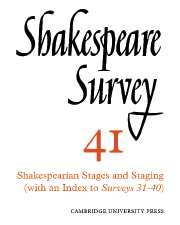Book contents
- Frontmatter
- The Shakespearian Stages, Forty Years On
- The Original Staging of The First Part of the Contention (1594)
- Charles Calvert’s Henry V
- Hamlet, An Apology for Actors, and The Sign of the Globe
- ‘Hid indeed within the centre’: The Hall/Finney Hamlet
- Malvolio and the Dark House
- The Text of Cressida and Every Ticklish Reader: Troilus and Cressida, The Greek Camp Scene
- Antony and Cleopatra, Act 4 Scene 16: ‘A Heavy Sight’
- The Tempest’s Tempest at Blackfriars
- Keats and Lucrece
- The Resources of Characterization in Othello
- Ovid and the Mature Tragedies: Metamorphosis in Othello and King Lear
- The Passing of King Lear
- Shakespeare Performances in London and Stratford-upon-Avon, 1986–7
- Professional Shakespeare Productions in the British Isles, January–December 1986
- The Year's Contributions to Shakespeare Studies: 1 Critical Studies
- 2 Shakespeare’s Life, Times, and Stage
- 3 Editions and Textual Studies
- Books Received
- Index to Volume 41
- General Index to Volumes 31-40
Charles Calvert’s Henry V
Published online by Cambridge University Press: 28 March 2007
- Frontmatter
- The Shakespearian Stages, Forty Years On
- The Original Staging of The First Part of the Contention (1594)
- Charles Calvert’s Henry V
- Hamlet, An Apology for Actors, and The Sign of the Globe
- ‘Hid indeed within the centre’: The Hall/Finney Hamlet
- Malvolio and the Dark House
- The Text of Cressida and Every Ticklish Reader: Troilus and Cressida, The Greek Camp Scene
- Antony and Cleopatra, Act 4 Scene 16: ‘A Heavy Sight’
- The Tempest’s Tempest at Blackfriars
- Keats and Lucrece
- The Resources of Characterization in Othello
- Ovid and the Mature Tragedies: Metamorphosis in Othello and King Lear
- The Passing of King Lear
- Shakespeare Performances in London and Stratford-upon-Avon, 1986–7
- Professional Shakespeare Productions in the British Isles, January–December 1986
- The Year's Contributions to Shakespeare Studies: 1 Critical Studies
- 2 Shakespeare’s Life, Times, and Stage
- 3 Editions and Textual Studies
- Books Received
- Index to Volume 41
- General Index to Volumes 31-40
Summary
It is an orthodoxy of theatre history that from the termination of Charles Kean’s management at the Princess’s Theatre in 1859 and that of Samuel Phelps at Sadler’s Wells in 1862 the English classical theatre endured an interregnum until Henry Irving established his own regime at the Lyceum in 1878. Exceptions are admitted: Charles Fechter’s romantic Hamlet (1861 and 1864) and the Bancrofts’ meticulously researched Merchant of Venice (1875), but for sustained continuity in Shakespearian revivals it is necessary to look north to Manchester, where the principles of Free Trade went hand in hand with the flowering of civic pride, creating, in Asa Briggs’s words, the ‘Symbol of a New Age’. There, in ‘Cottonopolis’, between 1864 and 1874, Charles Calvert mounted a sequence of twelve Shakespearian revivals, which his friend and coadjutant, the architect Alfred Darbyshire, described, in the language of his profession, as ‘the cope-stone of effort . . . placed upon the beautiful edifice raised by the metropolitan managers’.
- Type
- Chapter
- Information
- Shakespeare Survey , pp. 23 - 34Publisher: Cambridge University PressPrint publication year: 1989



